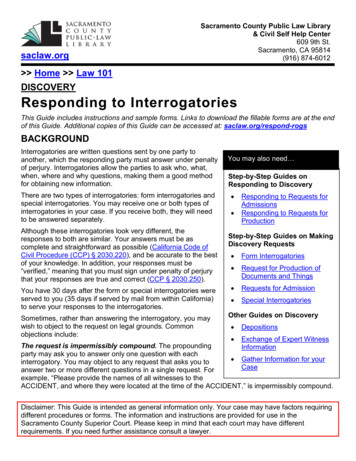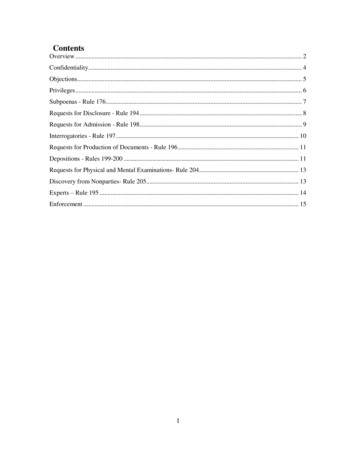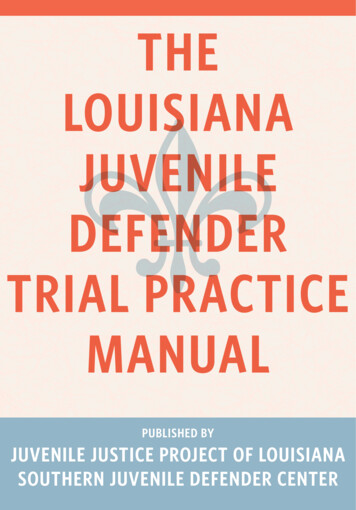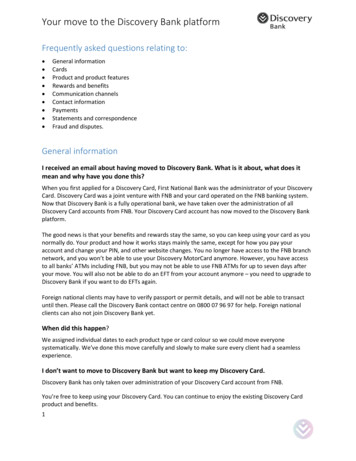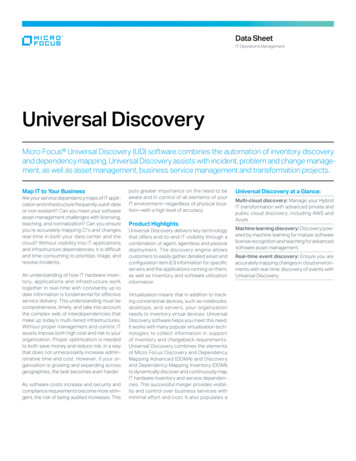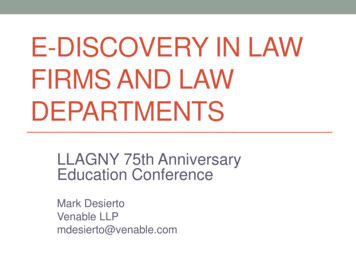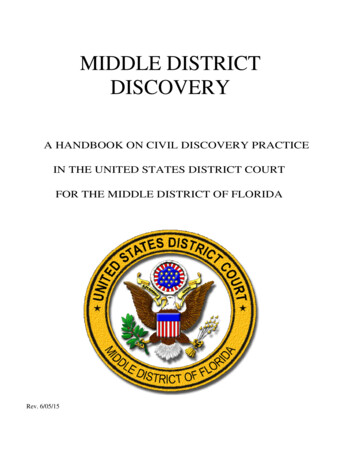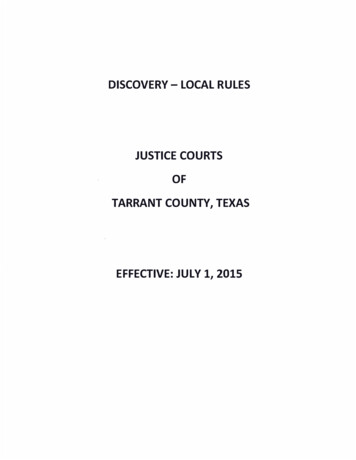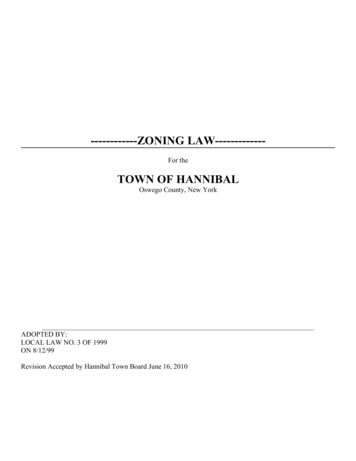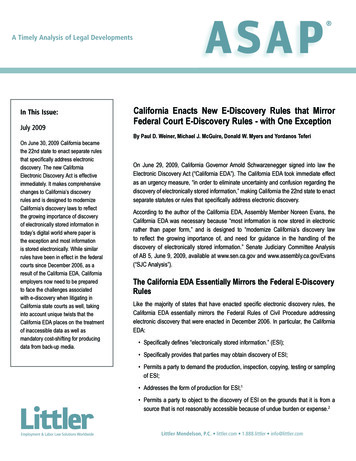
Transcription
A Timely Analysis of Legal DevelopmentsIn This Issue:July 2009On June 30, 2009 California becamethe 22nd state to enact separate rulesthat specifically address electronicdiscovery. The new CaliforniaElectronic Discovery Act is effectiveimmediately. It makes comprehensivechanges to California’s discoveryrules and is designed to modernizeCalifornia’s discovery laws to reflectthe growing importance of discoveryof electronically stored information intoday’s digital world where paper isthe exception and most informationis stored electronically. While similarrules have been in effect in the federalcourts since December 2006, as aresult of the California EDA, Californiaemployers now need to be preparedto face the challenges associatedwith e-discovery when litigating inCalifornia state courts as well, takinginto account unique twists that theCalifornia EDA places on the treatmentof inaccessible data as well asmandatory cost-shifting for producingdata from back-up media.ASAP California Enacts New E-Discovery Rules that MirrorFederal Court E-Discovery Rules - with One ExceptionBy Paul D. Weiner, Michael J. McGuire, Donald W. Myers and Yordanos TeferiOn June 29, 2009, California Governor Arnold Schwarzenegger signed into law theElectronic Discovery Act (“California EDA”). The California EDA took immediate effectas an urgency measure, “in order to eliminate uncertainty and confusion regarding thediscovery of electronically stored information,” making California the 22nd state to enactseparate statutes or rules that specifically address electronic discovery.According to the author of the California EDA, Assembly Member Noreen Evans, theCalifornia EDA was necessary because “most information is now stored in electronicrather than paper form,” and is designed to “modernize California’s discovery lawto reflect the growing importance of, and need for guidance in the handling of thediscovery of electronically stored information.” Senate Judiciary Committee Analysisof AB 5, June 9, 2009, available at www.sen.ca.gov and www.assembly.ca.gov/Evans(“SJC Analysis”).The California EDA Essentially Mirrors the Federal E-DiscoveryRulesLike the majority of states that have enacted specific electronic discovery rules, theCalifornia EDA essentially mirrors the Federal Rules of Civil Procedure addressingelectronic discovery that were enacted in December 2006. In particular, the CaliforniaEDA: Specifically defines “electronically stored information.” (ESI); Specifically provides that parties may obtain discovery of ESI; Permits a party to demand the production, inspection, copying, testing or samplingof ESI; Addresses the form of production for ESI;1 Permits a party to object to the discovery of ESI on the grounds that it is from asource that is not reasonably accessible because of undue burden or expense.2Littler Mendelson, P.C. littler.com 1.888.littler info@littler.com
ASAP Littler Mendelson, P.C. littler.com 1.888.littler info@littler.com Provides that even if a court determines that requested ESI is not reasonably accessible due to undue burden or cost, the courtmay still order production if the requesting party shows “good cause,” subject to certain conditions, including allocation of discoveryexpenses; Mandates that a court shall limit the discovery of any ESI - even from a source that is reasonably accessible - where: (1) it ispossible to obtain the information from another, less expensive or more convenient source; (2) the discovery sought is unreasonablycumulative or duplicative; (3) the party seeking the ESI has had ample opportunity to obtain the information sought; or (4) the likelyburden or expense of the discovery outweighs its likely benefit, taking into account the amount in controversy, the resources of theparties, the importance of the issues in the litigation, and the importance of the requested discovery in resolving the issues; Mandates that parties must submit a meet and confer declaration under section 2016.040 before bringing a motion for protectiveorder or a motion to compel with respect to ESI;3 Incorporates “safe harbor” provisions whereby a court “shall not impose sanctions on a party or any attorney of a party for failure toprovide electronically stored information that has been lost, damaged, altered, or overwritten as a result of the routine, good faithoperation of an electronic information system;” Sets forth a procedure to assert a claim of privilege or attorney work product protection of ESI inadvertently produced in discovery,establishes what the receiving party must do in response, and creates a mechanism for resolving such claims; and Specifically permits parties to seek ESI from third-parties via subpoenas, and applies to the subpoena process many of the sameprovisions that are in the provisions on motions for protective orders and motions to compel ESI.The California Distinction: How the California ESA Addresses Inaccessible ESIThe one area where the California EDA strays from the federal approach concerns the discovery of electronically stored information fromsources that a party identifies as not reasonably accessible.In particular, the Federal Rules take a two-tiered approach to inaccessible data, making a distinction under Federal Rule of CivilProcedure 26(b)(2)(B) between “accessible” and “inaccessible” data. Rule 26(b)(2)(B) is entitled “Specific Limitations on ElectronicallyStored Information,” and provides: “A party need not provide discovery of electronically stored information from sources that the partyidentifies as not reasonably accessible because of undue burden or cost.” Rule 26(b)(2)(B) also places the burden on the requestingparty to demonstrate “good cause” before an inaccessible data source must be searched. Thus, under the federal framework, arequesting party is encouraged to review and evaluate ESI produced from accessible sources before demanding ESI from inaccessiblesources, and a responding party is relieved of the need to produce inaccessible ESI unless the court orders otherwise.On the other hand, the California EDA does not contain explicit language that states a party does not have to provide discovery ofinaccessible ESI. Just as important, unlike the Federal Rules, which put the burden on the requesting party to file a motion to compel toobtain discovery from sources of ESI that are identified as not reasonably accessible, the California EDA appears to place the burdenon the producing party to file a Protective Order to claim that specified data sources are inaccessible due to undue burden or expense,and thus do not have to be searched. This was one of the main concerns among the more than 50 comments submitted for the versionof the California EDA that was circulated for public comment. In its report to the Members of the Judicial Council in support of the finalCalifornia EDA, the Policy Coordination and Liaison Committee (“PCLC Report”) responded to that criticism as follows:Although the committee supports the adoption of many of the provisions in the federal rules . . . , it disagreed with the suggestionthat the federal rules should be adopted in their entirety in California. The committee recommends the current legislativeproposal, even though it differs in some respects from the federal approach, because it will work better under Californiadiscovery law. . . .2ASAP is published by Littler Mendelson in order to review the latest developments in employment law. ASAP is designed to provide accurate and informative information and should not be considered legal advice.
ASAP Littler Mendelson, P.C. littler.com 1.888.littler info@littler.comThere are . . . some differences between federal and state discovery procedures and practices. In particular, federal discoverylaw requires the parties, without awaiting a discovery request, to provide initial disclosures, include a copy of, or a descriptionby category and location of, electronically stored information that the disclosing party may use in support of its claims ordefenses. The federal “two-tier” approach to the discovery of electronically stored information from a source that is notreasonably accessible operates within this discovery framework. The information is excluded from disclosure, unless a courtorders discovery from such sources. . . .By contrast, civil discovery in California is initiated by the parties. The proposed legislation described in this report is designedto work fairly and efficiently within this state’s discovery framework. Under California law, when a party demands the productionof documents or electronically stored information, the responding party has various options. It may agree to comply with thedemand. It may agree to comply in part. It may object to producing the information on various grounds, including that theproduction would be unduly burdensome. Or it may seek a protective order. If the responding party objects to a demand anddoes not seek a protective order, the demanding party may move to compel. If there is a motion for a protective order or amotion to compel, the parties must meet and confer to informally resolve each issue raised by the motion.The California discovery system operates effectively to resolve disputes. The proposed legislation is intended to enable thissystem to operate even better in resolving disputes relating to the discovery of electronically stored information. In contrastto the federal “two-tier” system that requires a court order to permit the discovery of information from sources that are notreasonably accessible, California’s amended discovery statutes should enable discovery disputes over such information to beresolved often without court order. . . .Some commentators expressed a concern that the proposed legislation will require the party from whom discovery ofelectronically stored information is sought to bring a motion for a protective order in every case. This is not the intent of thelegislation nor will it be its effect. As indicated, the usual California discovery procedures will apply to electronic discovery,including the ability of the party demanding the production of electronically stored information to file a motion to compel; hence,the resolution of disputes over the discovery of electronically stored information will not always require the filing of motion forprotective orders.4The California EDA Preserves Mandatory Cost-Shifting for Producing ESI from Back-Up MediaArticulated by the California Appeals Court in Toshiba v. Superior Court of Santa Clara CountyAnother California twist on inaccessible ESI concerns a decision from the California Court of Appeals about back-up tapes, which area classic source of ESI that courts treat as “not reasonably accessible.”5 In Toshiba, the court of appeals reversed a decision of thetrial court, and held that the cost-shifting provisions of California Code of Civil Procedure section 2031(g)(1) were mandatory, thus, thedemanding party had to pay the costs (possibly as much as 1.9 million) for recovering usable information from the responding party’scomputer backup tapes. The parties did not dispute that the defendant’s backup tapes were “data compilations” within the meaningof section 2031(g)(1) or that the defendant would incur some expense to manipulate the tapes in order to produce usable informationresponsive to plaintiff’s document demand. (The court left open for consideration on remand by the trial court the factual issue of whatconstituted “reasonable and necessary” costs to restore and mine data from the back-up tapes at issue.) In reaching this decision, thecourt instructed:Section 2031(g)(1) expressly provides that “[i]f necessary, the responding party at the reasonable expense of the demandingparty shall, . . . translate any data compilations . . . into reasonably useable form.” The clause is unequivocal. We need notengage in protracted statutory analysis because its plain language clearly states that if translation is necessary, the respondingparty must do it at the demanding party’s reasonable expense.[Plaintiff] contends that the cost shifting specified by section 2031(g)(1) may only be had upon a showing by the responding3ASAP is published by Littler Mendelson in order to review the latest developments in employment law. ASAP is designed to provide accurate and informative information and should not be considered legal advice.
ASAP Littler Mendelson, P.C. littler.com 1.888.littler info@littler.comparty that it will suffer undue burden or expense. This contention ignores the plain language of the statute. It is also basedalmost entirely upon federal law, which does not include a provision similar to the cost-shifting clause of section 2031(g)(1). . . Given the patent difference between the state and federal schemes, [Plaintiff’s] reliance on federal decisions is misplaced.[Plaintiff] also argues that interpreting section 2031(g)(1) as an exception to the general rule would conflict with settled federallaw. We agree that the cost-shifting provision of section 2031(g)(1) conflicts with the federal rule, but it appears to us that theLegislature intended it to be that way.The California EDA retains the following language from section 2031(g)(1) that was interpreted in Toshiba, re-lettered 2031.280(e):If necessary, the responding party at the reasonable expense of the demanding party shall, through detection devices, translateany data compilations included in the demand into reasonably usable form.Identical language is also contained in the California EDA section that authorizes subpoenas for ESI.Moreover, in its report to theMembers of the Judicial Council in support of the final California EDA, the Policy Coordination and Liaison Committee specificallystated:The committee’s legislative proposal does not change the language of section [2031(g)(1)] or the holding of the Toshibadecision. The proposal not only retains the current language [re-lettered as 2031.280(e)], but also includes it in new section1985.8 [concerning subpoenas for ESI].6Take AwaysGiven the new California EDA, it is more important than ever for practitioners in California to become intimately familiar with theirclient’s IT systems, policies and practices. In order to identify sources of information that are not accessible due to undue burden orcost, counsel must understand their client’s IT systems, where relevant data resides, and how difficult and/or burdensome it is to extractsuch information for discovery. Further, intimate knowledge of a client’s IT systems is critical for determining the form of production forESI, which now needs to be addressed at the time discovery requests are served or responded to. Without such knowledge, counselmay agree to produce ESI in a manner that a client’s IT systems will simply not allow and may fail to identify opportunities to takeadvantage of the cost-shifting provisions discussed above. These factors are especially important in labor and employment cases wherean employer often has complex and intricate IT systems that may contain relevant ESI (including back-up media, legacy systems, thirdparty hosted systems, etc.), while the plaintiff only has to search very basic sources of ESI (like home computers, e-mail systems andsocial networking sites).From a practical standpoint, the California twist on the treatment of inaccessible ESI is not that much different than the Federal Rules.At the end of the day, in federal court - and now under the EDA in California - responding parties have to be proactive if they intend tonot search or produce electronic data from inaccessible sources by: Promptly identifying sources of ESI that are not reasonably accessible by lodging a timely objection to a discovery request (inCalifornia) or listing them in self-executing disclosures (in federal court); Providing sufficient details about the burdens and costs of providing the discovery from and the likelihood of finding responsiveinformation on the sources identified; and Either party can file a motion to resolve the issue, with the responding party having the burden to establish the undue burden orcost of producing responsive ESI from the identified sources.However, in all California cases, given the cost-shifting provisions of section 2031.280(e) of the EDA that are unique to California,4ASAP is published by Littler Mendelson in order to review the latest developments in employment law. ASAP is designed to provide accurate and informative information and should not be considered legal advice.
ASAP Littler Mendelson, P.C. littler.com 1.888.littler info@littler.comemployers should be aggressive about seeking mandatory cost-shifting when dealing with a discovery request that calls for theproduction of ESI contained on any type of back-up media, in accordance with the mandates of Toshiba.Employers also need to be vigilant about protecting the inadvertent disclosure of privileged information when producing ESI. Like FederalRule of Civil Procedure 26(b)(5)(B), the California EDA does not address the substantive question of waiver, but instead merely providesa procedure for sequestering ESI until the court determines whether a waiver has occurred. Common law principles will still governwhether, and under what circumstances, inadvertent production of privileged or otherwise protected information results in a waiver,and the PCLC Report specifically states so.7 Given the explosion of ESI in the modern workplace, large volumes of ESI are routinelyin play in employment cases - even relatively “small” cases. Thus, employers should consider negotiating a comprehensive clawbackagreement (for example, the clawback agreement should cover the inadvertent production of metadata, an issue that is often overlooked)with plaintiff(s) at the outset of discovery to protect against privileged data slipping through. In appropriate cases, employers should alsocapitalize on state-of-the-art technologies to help protect against the inadvertent disclosure of privileged ESI. For example, once ESIhas been harvested, as part of the data processing/review protocol, using basic litigation support review technologies like Relativity ,counsel can run an electronic, “bulk-tag” search to identify potentially privileged documents/ESI that warrant a special level of review.Just like the federal rules, the California EDA also discourages gamesmanship when it comes to discovery of ESI, and instead places apremium on cooperation between counsel and their clients on issues surrounding ESI. This is consistent with leading industry guidanceon these issues.8Finally, as with Federal Rule 37(e), employers should not place too much reliance on the new “safe harbor” provisions of the CaliforniaEDA. Not only does the rule explicitly state that it does not alter preservation obligations federal courts also have consistently heldthat the virtually identical federal safe harbor rule does not exempt from sanctions a party who fails to stop the automatic operation ofa system that is eliminating information that may be discoverable in litigation, such as routine e-mail purges or backup tape recyclingprograms.The bottom line: the new California EDA underscores the importance of having both the substantive expertise in this critically importantarea of the law, as well as practical, hands-on experience to meet the demands of e-Discovery when litigating in today’s digital age inCalifornia state courts.Littler is one of the few firms in the Country that has a team of attorneys dedicated full-time to working with clients in the challengingfield of electronic discovery, a move that clearly emphasizes the Firm’s commitment to providing its clients with cutting-edge solutions inthis rapidly developing area. Littler’s E-Discovery lawyers provide focused guidance and expertise on all aspects of electronic discovery:from case- and client-specific advice about meeting preservation obligations; to working with Trial Teams to address “meet-and-confer”obligations; to developing strategies for efficient and effective data harvesting, analysis, review and production; to implementing costshifting/reduction strategies.Paul D. Weiner is a National E-Discovery Counsel in Littler Mendelson’s Philadelphia office. Michael J. McGuire is an E-Discovery Counsel in LittlerMendelson’s Minneapolis office. Donald W. Myers is an E-Discovery Senior Associate and Yordanos Teferi is an E-Discovery Associate in LittlerMendelson’s Philadelphia office. If you would like further information, please contact your Littler attorney at 1.888.Littler, info@littler.com, Mr. Weinerat pweiner@littler.com, Mr. McGuire at mmcguire@littler.com, Mr. Myers at dmyers@littler.com, Ms. Teferi at yteferi@littler.com.A party demanding ESI may specify the form in which it is to be produced and the responding party may object to a specified form of production; ifno form of production is specified, the responding party shall produce ESI in the form in which it is ordinarily maintained or a reasonably useable form.A party also does not need to produce the same ESI in more than one form. California EDA §§ 2031.030(a)(2); 2031.280(c) and (d)(1).15ASAP is published by Littler Mendelson in order to review the latest developments in employment law. ASAP is designed to provide accurate and informative information and should not be considered legal advice.
ASAP Littler Mendelson, P.C. littler.com 1.888.littler info@littler.comA producing party may also promptly seek a protective order on the grounds that the ESI sought is not reasonably accessible because of undueburden or expense. California EDA §§ 2031.060(a) - (c). Such a motion must be accompanied by a meet and confer declaration, and the producingparty bears the burden of demonstrating inaccessibility due to undue burden or expense. Id.2California EDA §§ 2031.060(a) and 2031.310(b)(2). The initial version of the California EDA that was circulated for public comment also containedlanguage supporting changes in the civil case management rules that would have created a duty to meet and confer on ESI discovery issues beforethe initial case management conference, similar to the meet and confer requirements of Federal Rule of Civil Procedure 26(f)(3)(C). See Invitation toComment LEG 08-01/W08-01, Rules Proposal, available at s/w08-01. While those provisionswere not included in the final California EDA, as noted above, meet and confer conferences are still required before a dispute concerning ESI can bebrought before a court.3See Judicial Council of California, Policy Coordination and Liaison Committee Report re: Electronic Discovery: Proposed Legislation, April 16, 2008,at 11 - 13, available at www.courtinfo.ca.gov.45Toshiba Am. Elec. Components, Inc. v. Superior Court of Santa Clara County, 124 Cal. App. 4th 762 (2004).See PCLC Report at 126. Compare also SJC Analysis, at 10 - 11 (“This bill would not affect the standard articulated in Toshiba v. Superior Courtregarding the allocation of costs for recovering ESI from back-up media. . . . [The procedures set forth in the California EDA] preserve the rulearticulated by Toshiba for the allocation of the financial burden of producing ESI from back-up media, and are consistent with the intent of the sponsorof this bill.”)6See PCLC Report, at 7 (“[The new procedure of section 2031.285] is not intended to modify substantive law, citing Reporter’s Notes to Rule No. 9of the National Conference of Commissioners on Uniform State Laws, Uniform Rules Relating to Discovery of Electronically Stored Information (“Therule does not address whether the privilege or protection that is asserted after production was waived by the production or ethical implications of useof such data. These issues are left to resolution by other law or authority”)).7See e.g., The Sedona Cooperation Proclamation, July 2008 (The Proclamation argues that cooperation is consistent with zealous advocacy, andis designed to facilitate collaborative, transparent discovery of ESI. It has been publicly endorsed by over forty federal and state judges across thecountry).86ASAP is published by Littler Mendelson in order to review the latest developments in employment law. ASAP is designed to provide accurate and informative information and should not be considered legal advice.
Electronic Discovery Act ("California EDA"). The California EDA took immediate effect as an urgency measure, "in order to eliminate uncertainty and confusion regarding the discovery of electronically stored information," making California the 22nd state to enact separate statutes or rules that specifi cally address electronic discovery.
